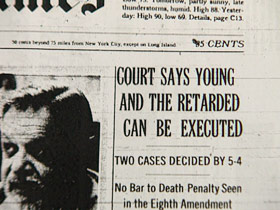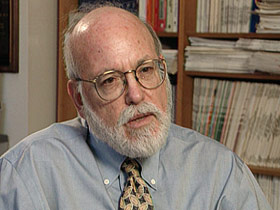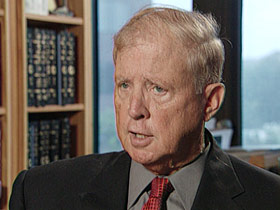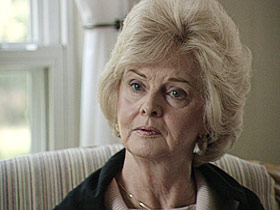In This Episode << SLIDE LEFT TO SEE ADDITIONAL SEGMENTS
Executing Juveniles
Note: An updated version of this story aired March 4, 2005.
BOB ABERNETHY, anchor: The U.S. Supreme Court begins its new term this Monday, and one of the first issues to be considered is: Should juveniles ever be executed? Fifteen years ago, the high court ruled that states could execute offenders as young as 16 if they chose to. But attitudes appear to be shifting. And the case now coming before the court could end that practice for good. Tim O’Brien reports.
TIM O’BRIEN: It started as a burglary at this home in Fenton, Missouri, about 30 miles south of St. Louis, early on a September morning in 1993. It turned into a gruesome murder.

ED KEMP (Jefferson County Sheriff’s Department): While in the home, the victim woke up, recognized both subjects. They bound her, put her in her own vehicle, transported her to a bridge, and threw her over alive.
O’BRIEN: Acting on an informant’s tip, police arrested two young suspects: 15-year-old Charlie Benjamin and 17-year-old Chris Simmons were picked up at their high school a day after the murder. After first denying any involvement, Simmons later gave a tearful confession to police:
CHRIS SIMMONS (Confessing on Tape): I had her tied up. She walked out on the bridge and [I] tied her hands and feet together — pushed her off.
UNIDENTIFIED POLICEMAN: Who pushed her?
Mr. SIMMONS: I did.
UNIDENTIFIED POLICEMAN: Who?
Mr. SIMMONS: I did.

UNIDENTIFIED POLICEMAN: You pushed her?
Mr. SIMMONS: I did.
O’BRIEN: Simmons even re-enacted the crime for police.
UNIDENTIFIED POLICEMAN #2 (On Police Video): So, this about where you threw her off?
Mr. SIMMONS (Gesturing): Yeah.
O’BRIEN: Simmons’s lawyer tried to get him to accept a deal: life in prison in exchange for a guilty plea. But Simmons wouldn’t hear of it.
DAVID CROSBY (Defense Attorney): Here’s a child that in Missouri couldn’t buy a car because he’s under age to contract, and yet he makes life-and-death decisions.
O’BRIEN: It was an open-and-shut case.
JURY FOREMAN (At Trial): We the jury find the defendant, Christopher Simmons, guilty of murder in the first degree.
O’BRIEN: The younger boy was sentenced to life with no parole. Simmons, 17, got the death penalty — the jury finding that the murder was aggravated in that it was committed to avoid detection and in the course of a kidnapping, another felony.

But a little over a year ago, the Missouri Supreme Court set aside Simmons’s death sentence, reducing it to life in prison with no parole. The court held it violates this country’s evolving standards of decency to execute anyone who was under 18 at the time of the crime — that it may have been permissible in the past, but that now it conflicts with the Eighth Amendment guarantee against cruel and unusual punishment.
The decision squarely contradicts a 1989 Supreme Court decision allowing the execution of juvenile offenders.
While it is most unusual for a state court to rule that a decision of the U.S. Supreme Court has become outdated, the Missouri court’s decision has generated broad support — including from the U.S. Conference of Catholic Bishops. Raymond Burke is Archbishop of St. Louis.
Archbishop RAYMOND BURKE (Archdiocese of St. Louis): When a young person commits a crime, granted, the crime itself is horrible; the degree of culpability is normally less.
O’BRIEN: The decision of the rural Missouri jury to execute Simmons is also being second-guessed and criticized by 18 recipients of the Nobel Peace Prize, including former Presidents Jimmy Carter, Mikhail Gorbachev, and Lech Walesa; also, South Africa’s Desmond Tutu — and the Dalai Lama.
In a joint “Friend of the Court” brief, they contend, “The death penalty for child offenders is contrary to internationally accepted standards of human rights.”

The American Bar Association, the American Medical Association, and the American Psychiatric Association have also weighed in, also urging that Simmons be spared.
Dr. RICHARD RATNER (American Psychiatric Association): We have learned a lot more about the function and the structure, and the development of the brain.
O’BRIEN: Dr. Ratner says not only has the execution of juvenile offenders become less acceptable, but new research suggests the court also got it wrong back in 1989 when it first authorized the practice.
Dr. RATNER: And in a nutshell, it is that the brain has not really matured, you do not really have an adult brain until you are in your early 20s.
O’BRIEN: You have empirical evidence of that?
Dr. RATNER: Yes, we do.
O’BRIEN: Ratner says new, sophisticated Magnetic Resonance Imaging — MRIs like this — show that juveniles use a different part of the brain in the decision-making process than adults, making them more likely to act irrationally, less likely to appreciate the consequences of what they do.
The case of 17-year-old Lee Malvo has galvanized public opinion on the execution of juvenile offenders. Malvo was convicted of participating in a random sniper spree that left 10 people dead in the Washington, DC area two years ago. He escaped the death penalty in one trial, but could still face death in another if the Supreme Court allows it.

PAUL EBERT (Prince William County Commonwealth’s Attorney): Well, I’m going to take a shot at him, yeah. We’ve pretty much made that decision.
O’BRIEN: In Virginia, no prosecutor has put more men on death row than Paul Ebert.
Mr. EBERT: I just don’t see how you can say someone who is 18 and one month should be treated differently from someone who is 17 and nine or 10 months.
O’BRIEN: Prosecutors in Missouri told the jury that Simmons believed he could get away with murder — because he was a juvenile.
JOHN APPELBAUM (Jefferson County Prosecutor, in June 1994): He used his age as a sword, saying “Kids, you can get away with this because nobody will think we’re capable of doing this.”
Mr. APPLEBAUM (Today): He was talking to people, trying to incorporate them into his plot. It doesn’t necessarily have to be Shirley Crook that night, that’s what was so scary about this case. It could have been anybody.

PERTIE MITCHELL (Victim’s Sister): And you know what they said? These boys went to school the next day and they were bragging about what they had done. They said, “Guess what we did last night? We beat up an old lady. And we took her out to the trestle and we pushed her off, and guess what she did? She went ‘bubble, bubble.'” You think that didn’t hurt us!
O’BRIEN: Who could do such a terrible thing? While prosecutors say the victim could have been anyone, Chris Simmons’s mother says the perpetrator could have been anyone’s son.
SHERYL HAYES (Defendant’s Mother): We were caring parents for him. We did everything we could. We probably spoiled him. But there were things he was doing, I had no idea he was doing. It’s broken my heart. You think about it every day. A lot of my thoughts is, if I could just turn time backwards and none of this had ever happened.
O’BRIEN: Two years ago, the Supreme Court, reversing itself, banned the death penalty for mentally retarded defendants. The court found a national consensus against the practice, noting the number of states opposing it had risen from two to 18. The trend is not quite so sharp with executing juvenile offenders: of the 37 states that allowed the death penalty in 1989, 12 prohibited the execution of anyone under 18. Nineteen of 38 states forbid it today.
While for the justices, whether that’s “cruel and unusual” may be an issue of pure constitutional law. But the question of executing juvenile offenders is inescapably as “moral” as it is “legal.” When it comes to the death penalty, how old is “too young”?
For RELIGION & ETHICS NEWSWEEKLY, I’m Tim O’Brien in Fenton, Missouri.
ABERNETHY: Around the country, there are now 73 Death Row inmates who were under 18 when they committed their crimes. If the Supreme Court rules that executing them would be unconstitutional, their sentences would be reduced to life in prison. If the court rules it is not unconstitutional, Christopher Simmons could face execution by lethal injection.

